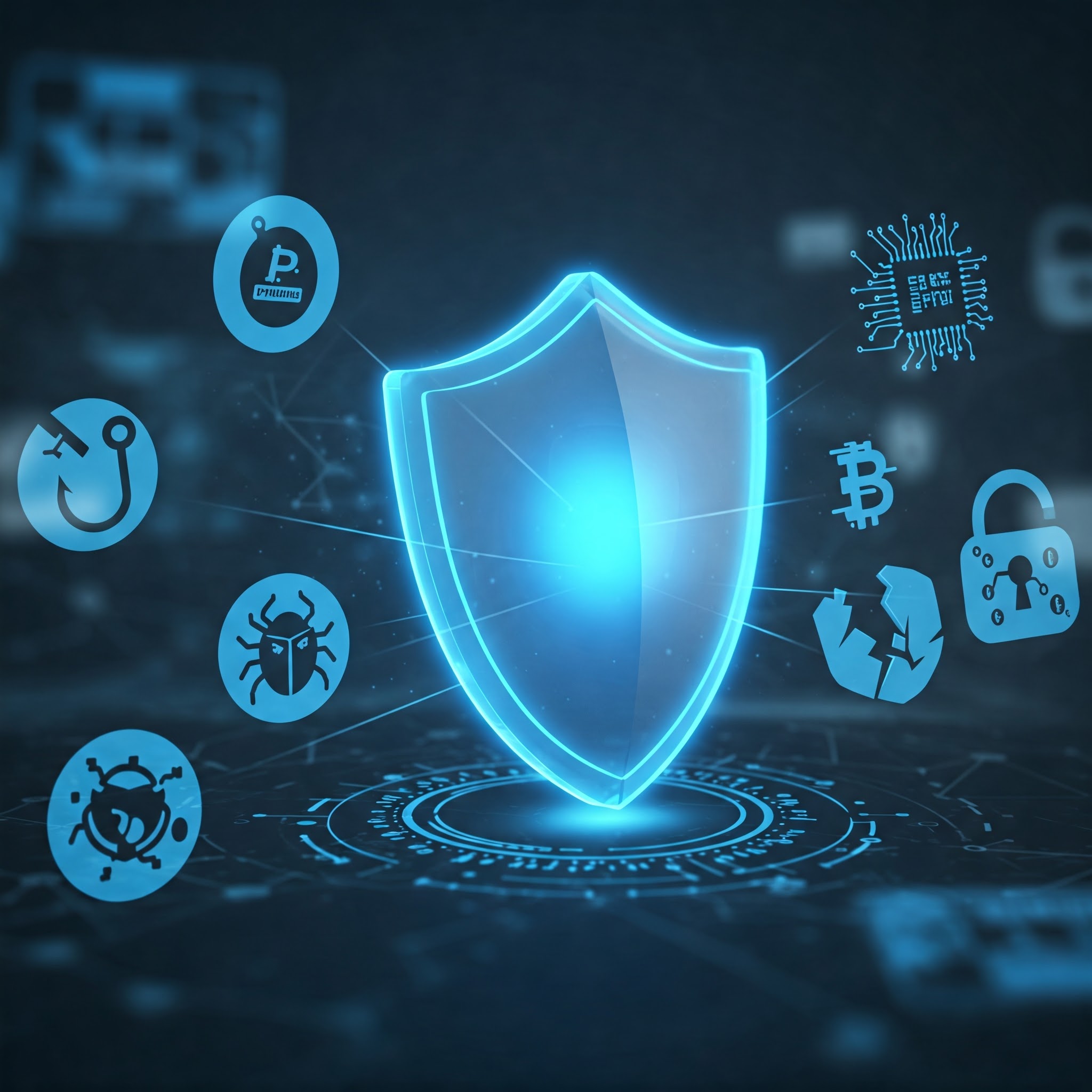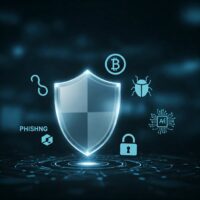The Digital Age Dilemma: Convenience vs. Catastrophic Risk
The digital revolution has woven itself into the fabric of our lives, offering unprecedented convenience and connectivity. We bank online, shop online, work online, and even manage our health online. But this interconnectedness comes at a steep price: an escalating crisis of identity theft and data breaches. In 2025, this crisis isn’t just a headline; it’s a pervasive threat impacting billions globally.
Identity Theft and Data Breaches: A Global Threat in 2025
The statistics are chilling. In the first half of 2024 alone, over one billion individuals were victims of data breaches, a staggering 490% increase from the previous year. This isn’t just a problem for large corporations; it’s a personal crisis affecting individuals from all walks of life. Cybercriminals are becoming more sophisticated, leveraging cutting-edge technologies like artificial intelligence (AI), quantum computing, and advanced social engineering techniques to exploit vulnerabilities in systems and human behavior.
What Exactly Are Identity Theft and Data Breaches?
To understand the threat, we need to define the core concepts:
- Identity Theft: This occurs when someone illegally obtains and uses your personal information – your Social Security number, bank account details, credit card numbers, medical records, or even your online credentials – for their own gain. This can lead to financial fraud, the opening of fraudulent accounts, damage to your credit score, and even criminal charges being filed in your name.
- Data Breaches: These are incidents where sensitive, confidential, or protected data is accessed, stolen, disclosed, or exposed without authorization. Data breaches can target individuals, businesses, government agencies, or any entity that stores digital information. Common targets include healthcare records, financial data, personally identifiable information (PII), intellectual property, and classified information.
The Inseparable Link Between Data Breaches and Identity Theft
Data breaches are often the primary source of the information used for identity theft. When a company suffers a data breach, the stolen information – often including names, addresses, dates of birth, Social Security numbers, and financial details – ends up in the hands of criminals. This information is then sold on the dark web or used directly by the attackers to commit various forms of identity theft.
Examples of Major Breaches Fueling Identity Theft (H3)
- Change Healthcare Breach (2024): This devastating breach exposed the records of 100 million patients, creating a goldmine for criminals to commit medical identity theft, insurance fraud, and other scams. The sheer scale of this breach highlights the vulnerability of the healthcare sector.
- Santander Bank Breach (2024): Compromising 30 million customer accounts, this breach led to widespread financial fraud and exposed millions to potential identity theft. This demonstrates the ongoing threat to the financial industry, despite significant investments in cybersecurity.
- Kaiser Foundation Breach: 13.4 million records exposed.
- Evolve Bank: 7.6 million Customers.
2025: A Year of Alarming Statistics and Emerging Threats

Data Breach Statistics: A Grim Picture
- Global Financial Losses: The average cost of a data breach reached a staggering $4.45 million in 2023, and this figure is expected to continue rising. The cost includes not only direct financial losses but also reputational damage, legal fees, regulatory fines, and the cost of remediation and recovery.
- Remote Work Risks: The shift to remote work has exacerbated the problem, adding an estimated $137,000 to the average cost of a data breach per incident. This is due to the increased attack surface and challenges in securing remote environments.
Industries Under Siege: The Hardest Hit Sectors
Certain industries are particularly attractive targets for cybercriminals:
- Healthcare: Healthcare organizations hold vast amounts of sensitive patient data, making them prime targets. Medical records are valuable on the black market because they can be used for insurance fraud, prescription drug scams, and even blackmail.
- Finance: Banks, credit card companies, and other financial institutions are constantly under attack. Cybercriminals seek to steal financial data, access accounts, and commit wire fraud.
- Government/Military: Government agencies and military organizations hold highly sensitive information, including national security data, making them targets for state-sponsored attackers and cyber espionage.
- Retail: E-commerce businesses and retailers collect extensive customer data, including payment information, making them attractive targets for financially motivated cybercriminals.
Emerging Threats in 2025: The Cybercriminal’s Arsenal
Cybercriminals are constantly evolving their tactics, techniques, and procedures (TTPs). Here are some of the most significant emerging threats in 2025:
AI-Powered Attacks: The Rise of the Intelligent Threat
Artificial intelligence (AI) is a double-edged sword. While it offers powerful defensive capabilities, it’s also being weaponized by cybercriminals:
- Automated Phishing Campaigns: AI can generate highly convincing phishing emails and messages that are personalized to the target, making them much more likely to succeed.
- Password Cracking: AI-powered tools can crack passwords much faster than traditional methods, especially weak or commonly used passwords.
- Mimicking User Behavior: AI can analyze user behavior and create realistic deepfakes or impersonate users to bypass security controls.
- Malware Generation: AI can be used to create new, polymorphic malware that is difficult for traditional antivirus software to detect.
Quantum Computing Risks: The Encryption Apocalypse?
Quantum computing, while still in its early stages, poses a fundamental threat to current encryption methods. Quantum computers have the potential to break widely used encryption algorithms like RSA and TLS, which protect virtually all online communication and data storage.
- “Harvest Now, Decrypt Later”: Cybercriminals are already collecting encrypted data, knowing that they may be able to decrypt it in the future when quantum computers become more powerful.
Non-Human Identity (NHI) Exploits: The Expanding Attack Surface
The number of non-human identities (NHIs) – machine identities like API keys, service accounts, and IoT devices – is exploding. These NHIs often have privileged access to sensitive systems and data, making them attractive targets.
- 45:1 Ratio: NHIs now outnumber human identities by a staggering 45 to 1, creating a vast and often poorly secured attack surface.
- Lack of Oversight: NHIs are often poorly managed, with weak or default passwords, and lack of proper monitoring.
Third-Party and Supply Chain Vulnerabilities: The Weakest Link
Attacks targeting third-party vendors and the software supply chain are becoming increasingly common and devastating.
- MOVEit Breach: This high-profile breach highlighted the risks associated with relying on third-party software. Attackers exploited a vulnerability in the MOVEit file transfer software to steal data from hundreds of organizations.
- Software Supply Chain Attacks: Attackers are increasingly targeting the software development process, injecting malicious code into legitimate software that is then distributed to unsuspecting users.
How to Prevent Identity Theft and Data Breaches: A Multi-Layered Approach
Protecting yourself and your organization from identity theft and data breaches requires a multi-layered approach that combines technology, processes, and people.
For Individuals: Taking Control of Your Digital Identity
- Monitor Your Credit Reports Regularly: Request free annual credit reports from each of the three major credit bureaus (Equifax, Experian, and TransUnion) and review them carefully for any unauthorized activity. Consider a credit monitoring service for real-time alerts.
- Enable Multi-Factor Authentication (MFA) Everywhere: MFA adds an extra layer of security by requiring a second factor of authentication, such as a code from your phone or a biometric scan, in addition to your password. Prioritize using authenticator apps or security keys over SMS-based MFA, which is more vulnerable to attacks.
- Use Strong, Unique Passwords (or Better Yet, Passkeys): Avoid using the same password for multiple accounts. Use a password manager to generate and store strong, unique passwords. Even better, transition to passwordless authentication using FIDO2-compliant passkeys whenever possible. Passkeys use biometrics or hardware security keys, eliminating the need for passwords altogether.
- Be Wary of Phishing Attempts: Be extremely cautious of suspicious emails, text messages, or phone calls asking for personal information. Never click on links or open attachments from unknown senders. Verify the sender’s identity independently before providing any information.
- Secure Your Home Network: Use a strong password for your Wi-Fi router and keep the firmware updated. Consider using a VPN (Virtual Private Network) when connecting to public Wi-Fi.
- Protect Your Devices: Install reputable antivirus and anti-malware software on all your devices and keep them updated. Enable automatic updates for your operating system and applications.
- Shred Sensitive Documents: Shred any documents containing personal or financial information before discarding them.
- Be Careful What You Share Online: Limit the amount of personal information you share on social media and other online platforms. Review your privacy settings and restrict access to your information.
- Use a Virtual Credit Card number: Several credit cards and finantial apps offer the option to make payments with a virtual credit card, wich are single use or have a limited time, increasing security.
For Organizations: Building a Robust Cybersecurity Posture
- Implement a Zero Trust Architecture: Zero Trust is a security framework that assumes no user or device, inside or outside the network, should be trusted by default. Every access request must be verified, regardless of its origin. This involves strong authentication, microsegmentation, and continuous monitoring.
- Encrypt Data at Rest and in Transit: Use strong encryption (e.g., AES-256) to protect sensitive data both when it’s stored (at rest) and when it’s being transmitted (in transit).
- Network Segmentation: Divide your network into smaller, isolated segments to limit the impact of a potential breach. If one segment is compromised, the attacker won’t be able to easily access other parts of the network.
- Regular Security Audits and Penetration Testing: Conduct regular security audits and penetration tests to identify vulnerabilities in your systems and processes. Engage third-party security experts to provide an independent assessment.
- Employee Training and Awareness: Human error is a major factor in many data breaches. Provide regular security awareness training to employees, covering topics like phishing, social engineering, password security, and data handling best practices. Conduct simulated phishing attacks to test employee awareness.
- Incident Response Plan: Develop and regularly test an incident response plan to ensure that your organization can respond effectively to a data breach. The plan should outline roles and responsibilities, communication procedures, and steps for containment, eradication, and recovery.
- Data Loss Prevention (DLP): Implement DLP tools to monitor and prevent sensitive data from leaving your organization’s control.
- Vulnerability Management: Establish a robust vulnerability management program to identify and remediate vulnerabilities in your systems and applications promptly.
- Third-Party Risk Management: Assess the security posture of your third-party vendors and partners. Ensure that they have adequate security controls in place to protect your data.
- Prepare for Post-Quantum Cryptography (PQC): Begin planning for the transition to quantum-resistant cryptography. Inventory your current encryption methods and identify systems that will need to be upgraded. Start exploring and testing PQC algorithms.
Legal and Regulatory Developments: The Shifting Landscape
The legal and regulatory landscape surrounding data privacy and cybersecurity is constantly evolving.
Global Privacy Laws: A Patchwork of Regulations
- EU’s eIDAS 2.0: This regulation mandates the use of decentralized digital identity wallets to reduce fraud and give users more control over their personal data.
- General Data Protection Regulation (GDPR): The GDPR, while not new, continues to have a significant impact on data privacy globally. It sets strict requirements for the processing of personal data of individuals in the European Union.
- US State Laws: The United States lacks a comprehensive federal privacy law, but many states have enacted their own privacy laws, such as the California Consumer Privacy Act (CCPA), the California Privacy Rights Act (CPRA), the Virginia Consumer Data Protection Act (VCDPA), the Colorado Privacy Act (CPA), and many more. These are constantly updating, like Texas (TDPSA) and Florida (FDBR).
- Other Countries: Many other countries around the world have enacted or are in the process of enacting data privacy laws, including Brazil, Canada, Australia, and Japan.
AI Regulations: Addressing the Ethical and Security Challenges
The rapid development of AI has raised concerns about its potential misuse.
- EU AI Act: This landmark legislation aims to regulate the development and use of AI, with a focus on high-risk AI systems. It addresses issues like surveillance, data distortion, and algorithmic bias.
- Colorado’s AI Act: Similar to the EU AI Act.
Compliance Challenges: Navigating the Complexity
Organizations face significant challenges in complying with this complex and evolving regulatory landscape.
- Fragmented Regulations: The lack of a single, global standard for data privacy and cybersecurity creates challenges for multinational organizations.
- Ethical Dilemmas: AI presents new ethical dilemmas, such as the potential for bias in algorithms and the misuse of biometric data.
- Data Localization Requirements: Some countries have data localization requirements that mandate that data be stored within their borders, creating challenges for cloud computing and data transfers.
The Future of Identity Security: Trends to Watch
Passwordless Authentication: The Dominant Paradigm
Passwordless authentication is rapidly gaining traction, driven by the increasing vulnerability of passwords to attacks.
- FIDO2 Standard: The FIDO2 standard, supported by tech giants like Google, Apple, and Microsoft, is becoming the industry standard for passwordless authentication.
- Biometrics and Hardware Tokens: Passwordless authentication relies on biometrics (fingerprint, facial recognition, iris scan) and hardware security keys to verify user identity.
Decentralized Identity Systems: Empowering Users
Blockchain-based decentralized identity systems are emerging as a potential solution to give users more control over their digital identities.
- Self-Sovereign Identity: Users can control their own identity data and share it selectively with service providers, reducing reliance on centralized databases.
- Verifiable Credentials: Digital credentials can be issued and verified on a blockchain, making them tamper-proof and more trustworthy.
AI-Powered Defense Mechanisms: Fighting Fire with Fire
AI is also being used to enhance cybersecurity defenses.
- Behavioral Biometrics: Analyzing user behavior patterns, such as typing speed, mouse movements, and device usage, to provide continuous authentication.
- Predictive Threat Detection: AI can analyze vast amounts of data to identify anomalies and potential threats in real time, significantly reducing response times.
- Automated Incident Response: AI can automate many aspects of incident response, such as containment and eradication, freeing up security teams to focus on more complex tasks.
Quantum-Safe Encryption: Preparing for the Quantum Threat
The development of quantum-safe encryption algorithms is crucial to protect data in the long term.
- NIST’s Post-Quantum Cryptography Standardization Process: The National Institute of Standards and Technology (NIST) is leading the effort to standardize quantum-resistant cryptographic algorithms.
- Lattice-Based Cryptography: Lattice-based cryptography is considered one of the most promising approaches to post-quantum cryptography.
Staying Ahead of the Curve: A Call to Action
The battle against identity theft and data breaches is an ongoing arms race. It requires vigilance, innovation, collaboration, and a proactive approach.
- Individuals: Take ownership of your digital security. Implement the preventative measures outlined above, stay informed about the latest threats, and be cautious online.
- Organizations: Invest in robust cybersecurity defenses, adopt a zero-trust framework, prioritize employee training, and comply with evolving regulations.
- Collaboration: Share threat intelligence and best practices across industries and with government agencies.
Specific Actions:
- Subscribe to Cybersecurity Newsletters and Blogs: Stay informed about the latest threats and vulnerabilities.
- Use Data Backup and Recovery Solutions: Regularly back up your important data to a secure location, such as a cloud-based service or an external hard drive. Consider using tools like Truehost Vault.
- Explore Decentralized Identity Solutions: Investigate decentralized identity solutions like MySudo to gain more control over your personal data.
- Regularly review privacy configuration in social media and apps.
Frequently Asked Questions (FAQ)
- Q: What was the biggest data breach in 2024?
- A: The Change Healthcare breach, impacting 100 million individuals, was one of the largest and most impactful.
- Q: How can I protect my business from AI-driven attacks?
- A: Implement multi-factor authentication, encrypt data at rest and in transit, conduct AI-specific risk assessments, and provide employee training on AI-related threats.
- Q: Are passwords obsolete?
- A: While not completely obsolete yet, passwords are becoming increasingly vulnerable. Passkeys and biometrics are rapidly replacing them as the preferred method of authentication.














